
Juan Bautista de Anza Bezerra Nieto was an expeditionary leader, military officer, and politician primarily in California and New Mexico under the Spanish Empire. He is credited as one of the founding fathers of Spanish California and served as an official within New Spain as Governor of the Province of New Mexico.

Mission San Antonio de Padua is a Spanish mission established by the Franciscan order in present-day Monterey County, California, near the present-day town of Jolon. Founded on July 14, 1771, it was the third mission founded in Alta California by Father Presidente Junípero Serra. The mission was the first use of fired tile roofing in Upper California. Today the mission is a parish church of the Diocese of Monterey and is no longer active in the mission work which it was set up to provide.

Mission San Juan Bautista is a Spanish mission in San Juan Bautista, San Benito County, California. Founded on June 24, 1797 by Fermín Lasuén of the Franciscan order, the mission was the fifteenth of the Spanish missions established in present-day California. Named for Saint John the Baptist, the mission is the namesake of the city of San Juan Bautista.
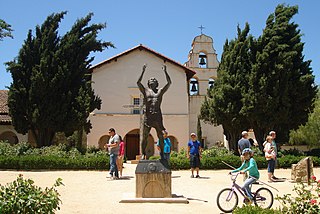
San Juan Bautista is a city in San Benito County, in the U.S. state of California. The population was 2,089 as of the 2020 census. San Juan Bautista was founded in 1797 by the Spanish under Fermín de Lasuén, with the establishment of Mission San Juan Bautista. Following the Mexican secularization of 1833, the town was briefly known as San Juan de Castro and eventually incorporated in 1896. Today, San Juan is a popular tourist destination, as the home of the San Juan Bautista State Historic Park and other important historic sites, as well as cultural institutions like El Teatro Campesino.

Juan Bautista Valentín Alvarado y Vallejo usually known as Juan Bautista Alvarado, was a Californio politician that served as Governor of Alta California from 1837-42. Prior to his term as governor, Alvarado briefly led a movement for independence of Alta California from 1836-37, in which he successfully deposed interim governor Nicolás Gutiérrez, declared independence, and created a new flag and constitution, before negotiating an agreement with the Mexican government resulting in his recognition as governor and the end of the independence movement.

The Diocese of Monterey in California is an ecclesiastical territory or diocese, of the Latin Church of the Catholic Church in the central coast region of California. It comprises Monterey, San Benito, San Luis Obispo and Santa Cruz counties.
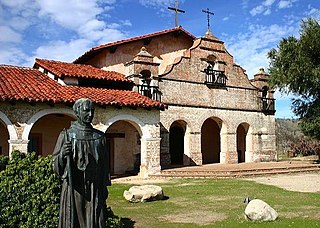
Jolon is a small unincorporated village in southern Monterey County, California. Jolon is located on the San Antonio River Valley, west of Salinas Valley and is entirely surrounded by Fort Hunter Liggett.

José Antonio Castro was a Californio politician, statesman, and general who served as interim Governor of Alta California and later Governor of Baja California. During the Bear Flag Revolt and the American Conquest of California, Castro led Mexican forces as the Commandante General of Northern California.
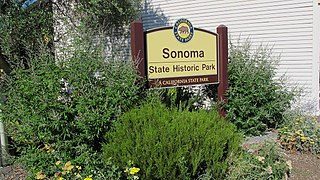
Sonoma State Historic Park is a California State Park located in the center of Sonoma, California. The park consists of six sites: the Mission San Francisco Solano, the Sonoma Barracks, the Blue Wing Inn, La Casa Grande, Lachryma Montis, and the Toscano Hotel.

The Juan de Anza House, also known as the Casa de Anza, is a historic adobe house in San Juan Bautista, California. Built around 1830, Casa de Anza is a well-preserved example of residential construction from the period of Mexican California. It was declared a National Historic Landmark in 1970.

The José Castro House, sometimes known as the Castro-Breen Adobe, is a historic adobe home in San Juan Bautista, California, facing the Plaza de San Juan. The Monterey Colonial style house was built 1838-41 by General José Antonio Castro, a former Governor of Alta California. It was later sold to the Breen family, who lived there until 1933, when the house became a museum as part of San Juan Bautista State Historic Park.

San Juan Bautista State Historic Park is a California state park encompassing the historic center of San Juan Bautista, California, United States. It preserves a significant concentration of buildings dating to California's period of Spanish and Mexican control. It includes the Mission San Juan Bautista, the Jose Castro House, and several other buildings facing the historic plaza. It became a state park in 1933 and was declared a National Historic Landmark in 1970. It is also a site on the Juan Bautista de Anza National Historic Trail.
Rancho La Natividad was a 8,642-acre (34.97 km2) Mexican land grant in present-day Monterey County, California given in 1837 by Governor Juan B. Alvarado to Manuel Butrón and his son-in-law, Nicolás Alviso. Rancho La Natividad and Rancho Los Vergeles were adjoining ranchos along Gabilan Creek north of present-day Salinas. The headquarters of each rancho were close to the entrance to the pass through the Gabilan Range to San Juan Bautista. The Rancho La Natividad grant encompassed present-day Natividad.

The Mexican Secularization Act of 1833, officially called the Decree for the Secularization of the Missions of California, was an act passed by the Congress of the Union of the First Mexican Republic which secularized the Californian missions. The act nationalized the missions, transferring their ownership from the Franciscan Order of the Catholic Church to the Mexican authorities.

Dutton Hotel, Stagecoach Station is located on Jolon Road in Jolon, California. What remains are ruins of an adobe inn that was established in 1849. The Dutton Hotel was a major stagecoach stop on El Camino Real in the late 1880s. The landmark was listed on the National Register of Historic Places on October 14, 1971.

George Hough Dutton was an American merchant and pioneer who came out west during the time of the California gold rush. He was a veteran of the American Civil War who served as a lieutenant in the Union Army. In 1866, Dutton settled in Jolon, California where he purchased the Antonio Ramirez adobe Inn in 1876 and converted it into a two-story hotel and stagecoach station. The hotel is now a landmark, named the Dutton Hotel, Stagecoach Station, which was listed on the National Register of Historic Places on October 14, 1971.
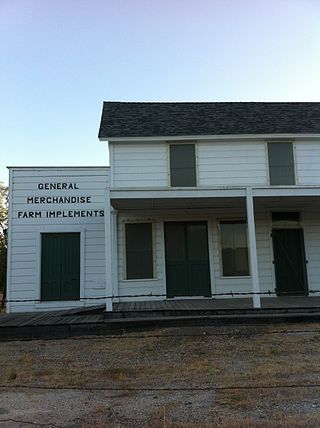
Tidball Store or Jolon General Store is located off Jolon Road in Jolon, California, United States, 1/4 mile south of the Dutton Hotel, Stagecoach Station. The store was constructed by pioneer, Thomas Theodore Tidball, from the remains of an old adobe inn, built in 1868 by Flint & Bixby Stage Lines. Tidball supplied food, clothing, building supplies and other necessities to customers traveling through and to local ranchers and miners. The store was a major stagecoach stop on the old El Camino Real in the late 1880s. The landmark was listed on the National Register of Historic Places on December 12, 1976. It is the only standing commercial building of Jolon, once a major community of southern Monterey County.
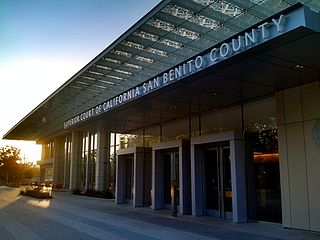
The Superior Court of California, County of San Benito, also known as the San Benito County Superior Court or San Benito Superior Court, is the branch of the California superior court with jurisdiction over San Benito County.

San Diego Viejo Plaza,, also called Plaza de Las Armas, Old Town Plaza, Washington Square, is a historical site in San Diego, California. San Diego Viejo Plaza site is a California Historical Landmark No. 63, listed on December 5, 1932. The plaza was the center of Pueblo de San Diego founded in 1835 in Alta California.




















